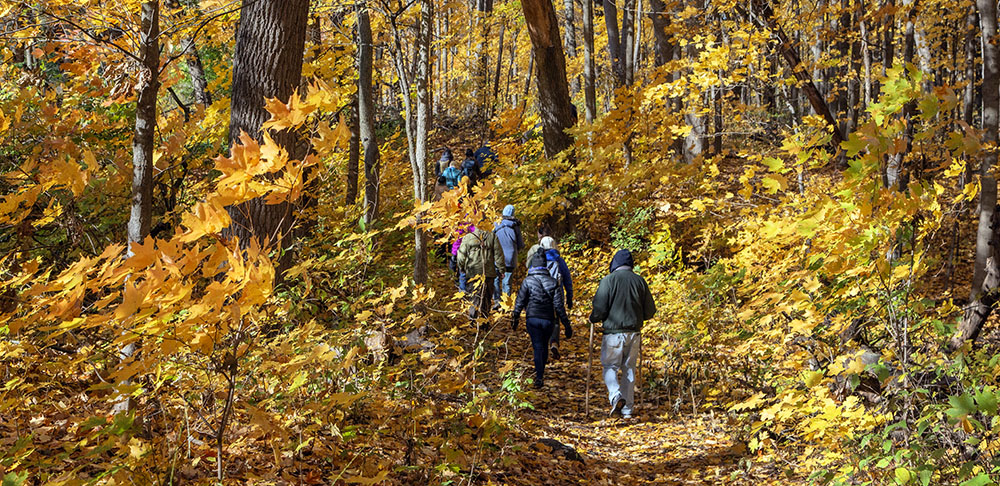
Mangan Woods: A surprising hidden gem shaped by the glaciers!
November 14, 2023 | Topics: Places, Spotlight
By Eddee Daniel
I took a break from exploring the Ice Age Trail, which runs closest to Milwaukee in Washington and Waukesha Counties, by returning to one of my favorite hidden gems in Milwaukee County: Mangan Woods. Lo and behold, I learned as much about the glaciers there as almost anywhere I’ve been on the Ice Age Trail itself. Turns out that the lovely topography of Mangan Woods was the result of the same glacial forces that created the far more famous kettle, moraine, kame, etc. features along the Ice Age Trail.
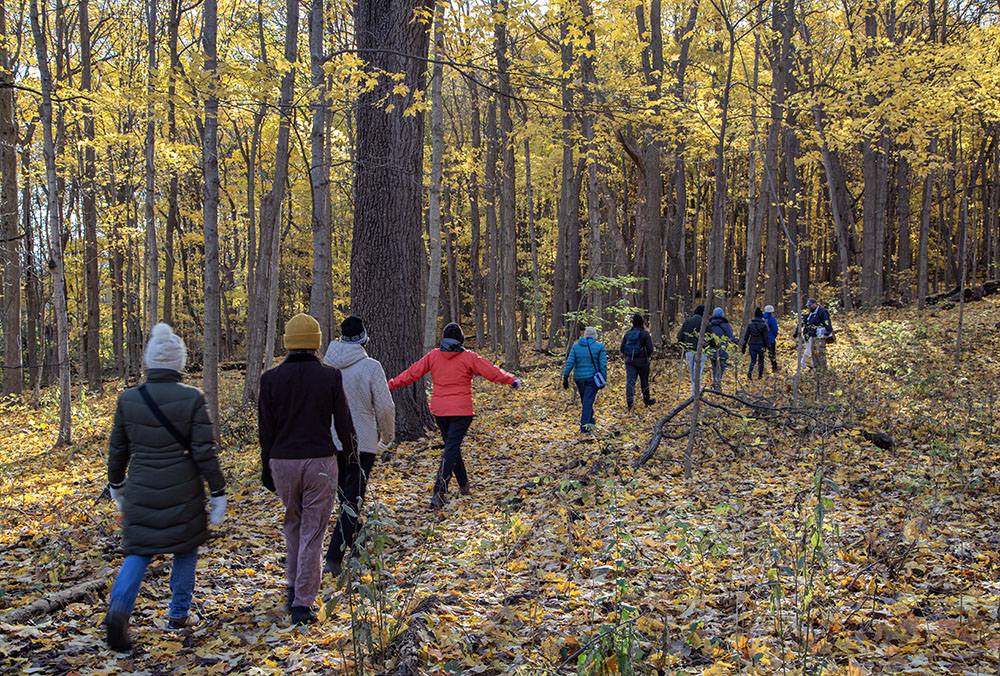
Making that connection was my guide, Howard Aprill, who works as a naturalist for Wehr Nature Center. I joined a large group that he led, sponsored by the Natural Resources Foundation of WI. Truly hidden, as well as a gem, Mangan Woods is part of the Milwaukee County Park System but not listed on its website directory as a park. Technically part of the Root River Parkway, it is squeezed between Whitnall Park and The Rock Sports Complex. The entrance is on 92nd Street, but the sign there reads “Ross Lodge,” which is a rentable facility also located there and an extension of Wehr Nature Center in Whitnall Park.
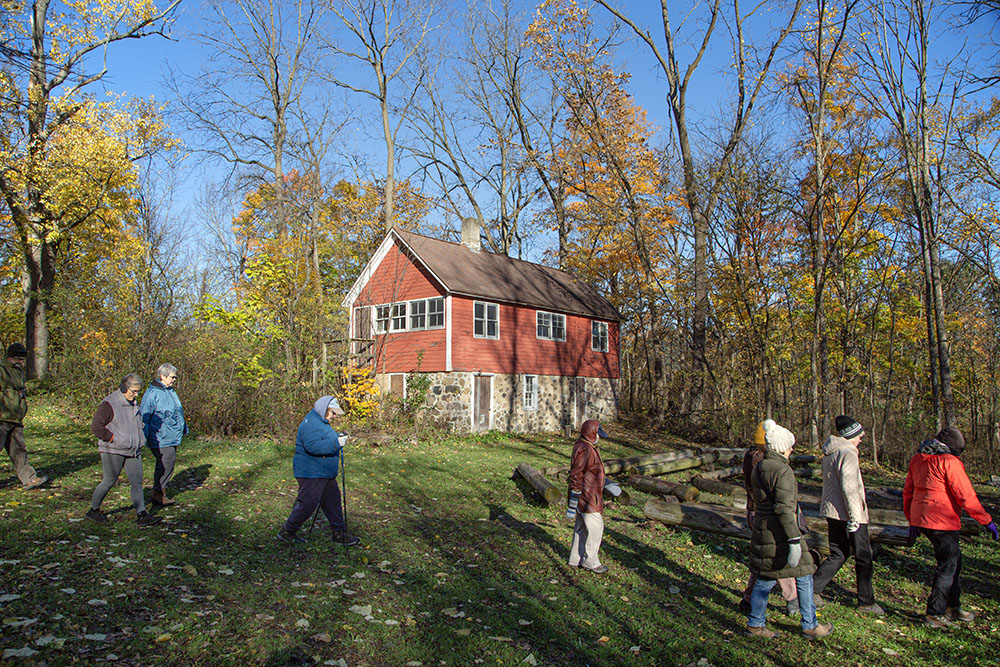
As if that wasn’t confusing enough, Mangan Woods is also home to one of the premier mountain bike trails in the area, the Kegel Alpha Trail. This gem is not hidden to mountain bikers! It hadn’t occurred to me before the tour that the rugged terrain that appeals to the mountain bikers is a legacy of the Ice Age.

Our guide began with a phrase that he repeated periodically throughout the tour: “The past is always present; everything is connected; people make all the difference.” He explained it all as we went along. From Ross Lodge we proceeded downhill past a small red cabin that began its life, Aprill told us, as a chicken coop when this was a farmstead owned by Mr. Mangan. The former coop has been repurposed as a classroom by Wehr Nature Center. We hadn’t gone more than fifty feet into the woods when Aprill stopped in front of some shrubbery. I’m quite sure that had I been on my own I would have continued right past without noticing the remains of a low foundation wall hidden underneath the foliage. The past is always present.

Aprill speculated as to the origins of the ruin and its function on the Mangan farm, but was convinced that it had been made from glacial stones collected in the woods. He took us along the trail until we came to a boulder that seemed out of place on the hillside. Looking around we could easily make out quite a few other smaller rocks poking up from the leaf litter. These are known as glacial erratics, random stones picked up and carried by the glacier until released by the melting ice. “Think of the glacier,” Aprill said, “as both a bulldozer pushing the earth and a conveyer belt, carrying debris along with it.” This igneous (volcanic) rock, which originated somewhere far to the north in Wisconsin or even Canada, is very different from the sedimentary limestone that occurs naturally in this area. Everything is connected.
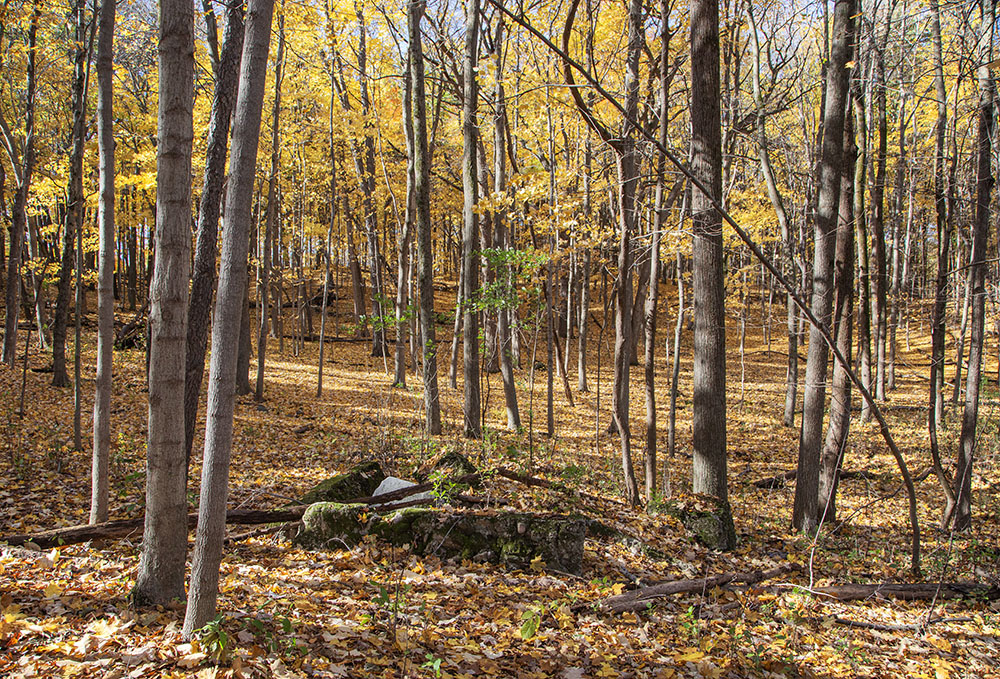
As we proceeded to walk through the woods, the trail rose and fell with the uneven glacial terrain. Moraines, we learned, were not only created by the bulldozing outer edge of the glaciers, but in intermediate locations like this one, between lobes or sections of the ice sheet. And kettles? When Aprill brought them up, I immediately brought to mind the large, dramatic depressions—often filled with water—surrounded by the high ridges of moraines that I’d recently seen along the Ice Age Trail in Washington County.
Imagine my surprise when the group stopped next to a barely noticeable shallow depression just off the trail. Aprill stepped down into it, dropping a mere two or three feet. Kettles come in all sizes, just as the chunks of glacier that created the kettles came in all sizes. What’s most important about this small depression in the forest is not its origin as a kettle but the ephemeral pond that forms in it each spring. The habitat thus created is essential to certain amphibious wildlife like salamanders and toads. It is also one of the most threatened of habitats, too easily overlooked, dismissed, bulldozed. But here it is protected. People make all the difference.

I wondered how someone with an untrained eye, like me, might tell if any given depression in the terrain was a kettle or human-made. Our guide had that question covered, too. We hiked along the side of the moraine to a point where we came to an obvious gouge cut into it. This, Aprill told us, was a gravel pit on the Mangan farm where limestone rocks were excavated from amongst the glacial till, probably to make lime for cement. Everything is connected.
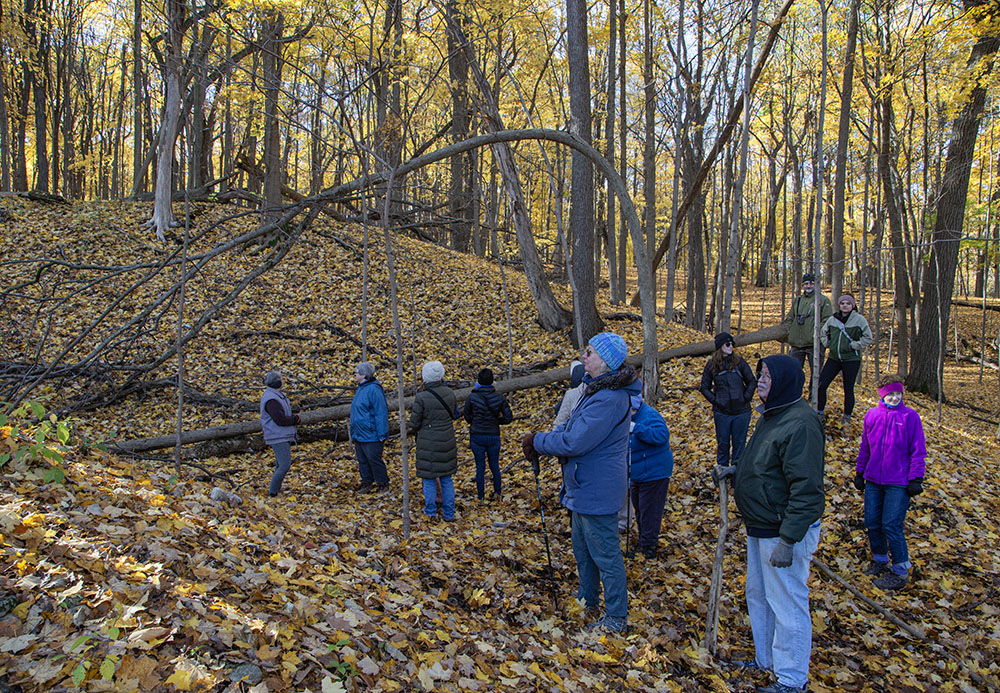
Gesturing to all the trees around us, Aprill pulled a laminated image out of his pack showing the retreating glacier as it might have looked 17,000 years ago. Imagine this land completely stripped of vegetation, he said to us. It took thousands of years for the forest to grow and mature to this point. He praised the condition of Mangan Woods, with young trees mixed in with mature ones, saying that this land clearly had never been plowed. Of course, the slopes and the gravelly composition of the moraines would have made that difficult! Our glacial past is always present.
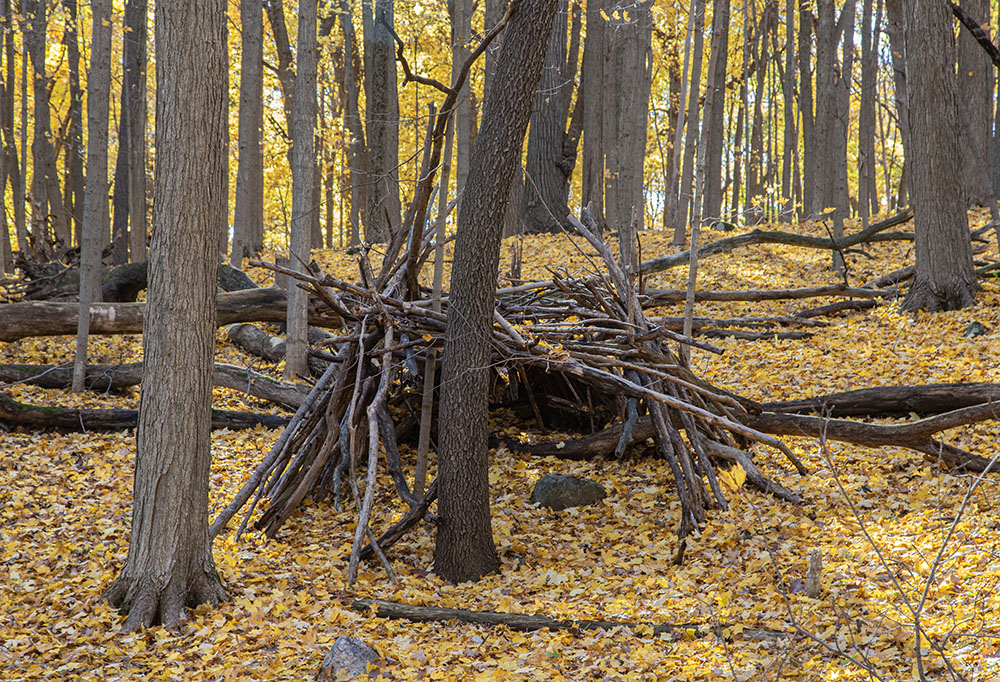
Except for the Driftless Area of southwestern Wisconsin, the entire state was not simply covered by glaciers during the last Ice Age. It was indelibly shaped by them. While the urbanization of Milwaukee County has made this ancient history hard to discern, here in a hidden corner of county parkland is a revelatory gem where you can still find evidence of it. And after you finished hiking—or biking—in Mangan Woods, you can walk across 92nd Street and find plenty more to do in Whitnall Park.
The autumn colors were just as radiant in Whitnall Park as in Mangan Woods, so I spent some additional time capturing the following from there.


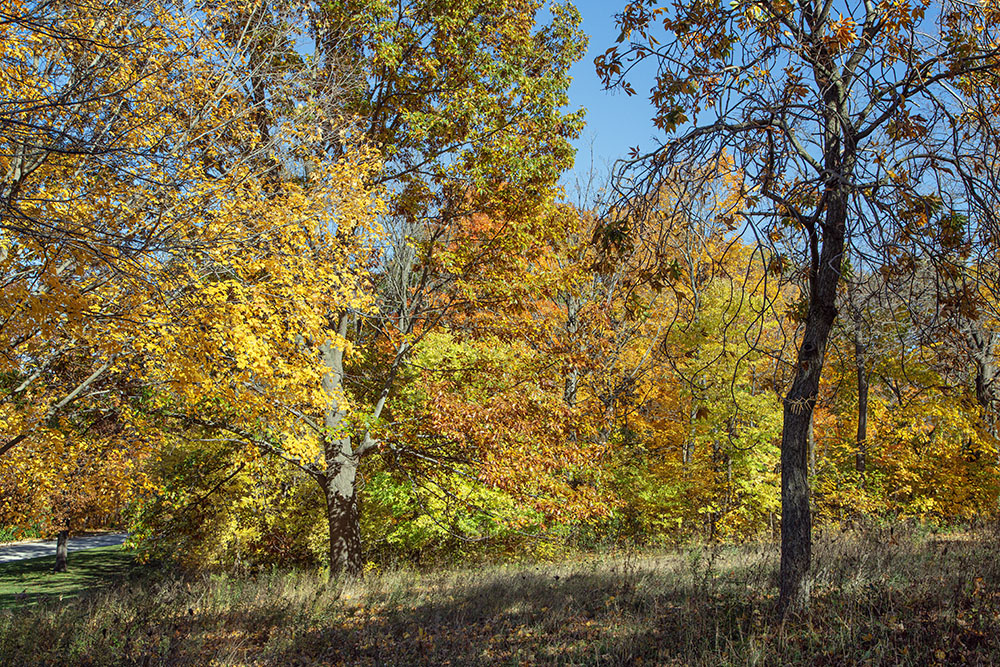

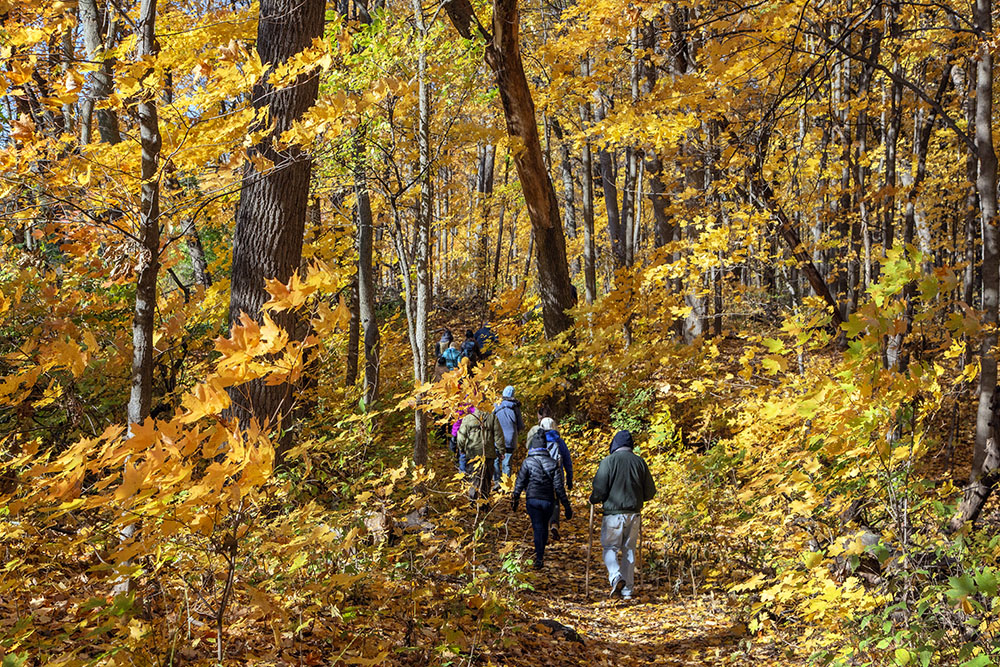
Related stories
Mangan Woods: 5 Great Milwaukee-Area Parks and Why You Should Visit
Wehr Nature Center: Area Nature Centers Tap Maples for Syrup—and Fun!
Accessibility is front and center for the Wehr Nature Center Healthy County Challenge!
Ice Age Trail: Ridge Run Park—A Glacial Wonderland in All Seasons!
Autumn Splendor on the Ice Age Trail – Milwaukee River Segment!
Duluth woman aims to complete winter thru-hike of 1,200-mile Ice Age Trail
The Ice Age Trail – Waterville Segment to be improved!
Hiking with the Ice Age Trail Alliance
For more information about and additional photos from Mangan Woods go to our Find-a-Park page.
For more information about the Ice Age and Wisconsin Geology go to the Wisconsin Geological and Natural History Survey website.
The Milwaukee County Parks Department and the Natural Resources Foundation of WI are project partners of A Wealth of Nature. Eddee Daniel is a board member of Preserve Our Parks.
2 thoughts on "Mangan Woods: A surprising hidden gem shaped by the glaciers!"
Comments are closed.


I had always presumed that Ross Lodge and the riad to it was a private one. Can one go in there any time or is permission needed?
The Ross Lodge parking lot is also the lot for Mangan Woods. Open to all anytime!